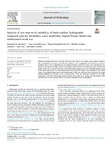Mostrar o rexistro simple do ítem
Analysis of two sources of variability of basin outflow hydrographs computed with the 2D shallow water model Iber: Digital Terrain Model and unstructured mesh size
| dc.contributor.author | García-Alén, Gonzalo | |
| dc.contributor.author | González-Cao, José | |
| dc.contributor.author | Fernández-Novoa, Diego | |
| dc.contributor.author | Gómez-Gesteira, Moncho | |
| dc.contributor.author | Cea, Luis | |
| dc.contributor.author | Puertas, Jerónimo | |
| dc.date.accessioned | 2022-09-05T11:42:13Z | |
| dc.date.available | 2022-09-05T11:42:13Z | |
| dc.date.issued | 2022 | |
| dc.identifier.citation | García-Alén, G., González-Cao, J., Fernández-Nóvoa, D., Gómez-Gesteira, M., Cea, L., Puertas, J. (2022). Analysis of two sources of variability of basin outflow hydrographs computed with the 2d shallow water model iber: digital terrain model and unstructured mesh size. Journal of Hydrology, 612, 128182. | es_ES |
| dc.identifier.uri | http://hdl.handle.net/2183/31405 | |
| dc.description | Financiado para publicación en acceso aberto: Universidade da Coruña/CISUG | es_ES |
| dc.description.abstract | [Abstract:] Modelling hydrological processes with fully distributed models based on the shallow water equations implies a high computational cost, which often limits the resolution of the computational mesh. Therefore, in practice, modellers need to find a compromise between spatial resolution, numerical accuracy and computational cost. Moreover, this balance is probably related to the accuracy and resolution of the underlying Digital Terrain Model (DTM). In this work, it is studied the effect of the DTM resolution and the size of the computational mesh on the results and on the runtime of a hydrological model based on the 2D shallow water equations. Seven rainfall events in four different basins have been modelled using 3 DTMs and 3 different mesh resolutions. The results obtained highlight the relevance of the vertical accuracy versus the horizontal resolution of the DTMs. Furthermore, it has been observed that mesh resolutions greater than 25 m, together with LiDAR-based DTMs with horizontal resolution greater than 25 m, provide comparable outflow hydrographs. | es_ES |
| dc.description.sponsorship | Xunta de Galicia; ED481B-2021-108 | es_ES |
| dc.description.sponsorship | Xunta de Galicia; ED431C 2021/44 | es_ES |
| dc.description.sponsorship | Xunta de Galicia; ED431C 2018/56 | es_ES |
| dc.description.sponsorship | Fondo Europeo de Desarrollo Regional (FEDER); 0034_RISC_ML_6_E | es_ES |
| dc.language.iso | eng | es_ES |
| dc.publisher | Elsevier | es_ES |
| dc.relation.uri | https://doi.org/10.1016/j.jhydrol.2022.128182 | es_ES |
| dc.rights | Atribución-NoComercial-SinDerivadas 3.0 España | es_ES |
| dc.rights.uri | http://creativecommons.org/licenses/by-nc-nd/3.0/es/ | * |
| dc.subject | SRTMIGN | es_ES |
| dc.subject | Digital elevation model | es_ES |
| dc.subject | Iber | es_ES |
| dc.subject | Mesh size | es_ES |
| dc.subject | Runoff | es_ES |
| dc.title | Analysis of two sources of variability of basin outflow hydrographs computed with the 2D shallow water model Iber: Digital Terrain Model and unstructured mesh size | es_ES |
| dc.type | info:eu-repo/semantics/article | es_ES |
| dc.rights.access | info:eu-repo/semantics/openAccess | es_ES |
| UDC.journalTitle | Journal of Hydrology | es_ES |
| UDC.volume | 612, part B | es_ES |
| UDC.startPage | 128182 | es_ES |
| dc.identifier.doi | 10.1016/j.jhydrol.2022.128182 |






